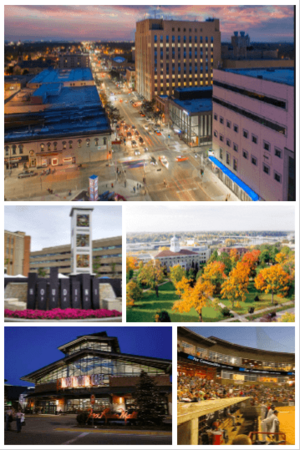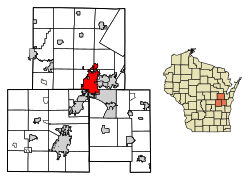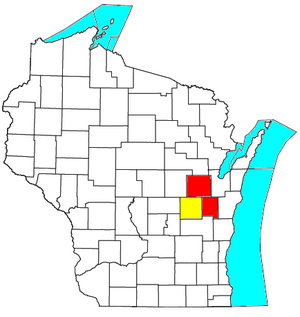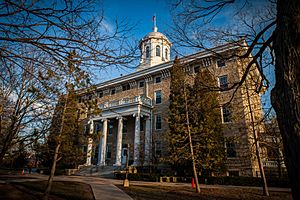Appleton, Wisconsin facts for kids
Quick facts for kids
Appleton, Wisconsin
|
|
|---|---|

Clockwise from top: Downtown Appleton Skyline, Main Hall (Lawrence University), Neuroscience Group Field at Fox Cities Stadium, Fox River Mall, Houdini Plaza
|
|
| Motto(s):
"One Great Place"
|
|

Location of Appleton in Outagamie, Calumet, and Winnebago Counties, Wisconsin
|
|
| Country | |
| State | |
| Counties | Outagamie, Calumet, Winnebago |
| Surrounding Towns | Grand Chute, Little Chute, Menasha, Kimberly |
| Settled | 1835 |
| Incorporated | May 2, 1857 |
| Named for | Samuel Appleton |
| Government | |
| • Type | Mayor-Council |
| Area | |
| • City | 25.29 sq mi (65.49 km2) |
| • Land | 24.79 sq mi (64.20 km2) |
| • Water | 0.50 sq mi (1.29 km2) 1.97% |
| Elevation | 790 ft (240 m) |
| Population
(2020)
|
|
| • City | 75,644 |
| • Density | 2,989.15/sq mi (1,154.12/km2) |
| • Urban | 216,154 (US: 165th) |
| • Metro | 236,126 (US: 194th) |
| • Metro density | 2,160/sq mi (834/km2) |
| Demonym(s) | Appletonians |
| Time zone | UTC−06:00 (CST) |
| • Summer (DST) | UTC−05:00 (CDT) |
| ZIP Code |
54911, 54912, 54913, 54914, 54915, 54919
|
| Area code(s) | 920 |
| FIPS code | 55-02375 |
| GNIS feature ID | 1560914 |
| Major airport | Appleton International Airport (ATW) |
| Major Routes | |
Appleton is a city in Outagamie, Calumet, and Winnebago counties in the U.S. state of Wisconsin. One of the Fox Cities, it is situated on the Fox River, 30 miles (48 km) southwest of Green Bay and 100 miles (160 km) north of Milwaukee. Appleton is the county seat of Outagamie County. As of the 2020 Census it had a population of 75,644, making it the sixth largest city in Wisconsin. Appleton is a part of the Fox Cities metropolitan area, the third largest in the state behind Milwaukee and Madison.
Appleton serves as the heart of the Fox River Valley, which is home to Lawrence University, the Fox Cities Exhibition Center, Fox Cities Performing Arts Center, Fox River Mall, Neuroscience Group Field at Fox Cities Stadium, Appleton International Airport, and the Valley's two major hospitals: St. Elizabeth Hospital and ThedaCare Regional Medical Center–Appleton. It also hosts regional events such as Octoberfest and the Mile of Music.
Contents
History
Fur traders seeking to do business with Fox River Valley Native Americans were the first European settlers in Appleton. Hippolyte Grignon built the White Heron in 1835 to house his family and serve as an inn and trading post.
Appleton was settled in 1847 and incorporated as a village in 1853. John F. Johnston was the first resident and village president. Home to Lawrence University, Appleton grew along with the school. With the financial backing of Amos A. Lawrence, the Lawrence Institute was chartered in 1847. Samuel Appleton, Lawrence's father-in-law from New England who never visited Wisconsin, donated $10,000 to the newly founded college library, and his name was given to the community in appreciation.
The community was incorporated as a city on March 2, 1857, with Amos Storey as its first mayor. Early in the 20th century, it adopted the commission form of government. In 1890, 11,869 people lived in Appleton; in 1900, there were 15,085; in 1910, 16,773; in 1920, 19,571; and in 1940, 28,436.
The paper industry, beginning with the building of the first paper mill in the city in 1853, has been at the forefront of the development of Appleton. In order to provide electricity to the paper industry, the nation's first hydro-electric central station, the Vulcan Street Plant on the Fox River, began operation on September 30, 1882. The power plant also powered the Hearthstone House, the first residence in the world powered by a centrally located hydroelectric station using the Edison system.
Shortly thereafter, in August 1886, Appleton was the site for another national first, the operation of a commercially successful electric streetcar company. Electric lights replaced gas lamps on College Avenue in 1912. Appleton also had the first telephone in Wisconsin, and the first incandescent light in any city outside of the East Coast.
Appleton's tallest building, the 222 Building was built in 1952. The Valley Fair Shopping Center, built in 1954, laid claim to being the first enclosed shopping mall in the United States, although this claim is disputed by other malls. In 2007 most of the structure was demolished, leaving only its east wing and a movie theater. A Pick 'n Save Food Center now stands in its place.
Sociologist James W. Loewen, in his book Sundown Towns: A Hidden Dimension of American Racism labeled Appleton a sundown town—a town that was intentionally all white. In these towns, black people were not allowed inside the town limits after dark.
In May 2016, a report by 24/7 Wall St. found that Appleton had the highest rate of self-reported binge and heavy drinking in the country.
Geography
Appleton is located at 44°16′N 88°24′W / 44.267°N 88.400°W (44.278819, -88.392625). According to the United States Census Bureau, the city has a total area of 24.82 square miles (64.28 km2), of which, 24.33 square miles (63.01 km2) is land and 0.49 square miles (1.27 km2) is water.
Climate
Appleton has a humid continental climate typical of Wisconsin. Summers are warm to hot and winters are rather cold in comparison. Precipitation is relatively moderate compared to other areas close to the Great Lakes, which means lesser snowfall in winter than in many other cold areas.
A dew point of 90 °F was observed at Appleton at 5 p.m. on July 13, 1995. This is tied for the second highest dew point ever observed in the United States.
| Climate data for Appleton | |||||||||||||
|---|---|---|---|---|---|---|---|---|---|---|---|---|---|
| Month | Jan | Feb | Mar | Apr | May | Jun | Jul | Aug | Sep | Oct | Nov | Dec | Year |
| Record high °F (°C) | 55 (13) |
59 (15) |
81 (27) |
89 (32) |
94 (34) |
101 (38) |
107 (42) |
103 (39) |
101 (38) |
89 (32) |
75 (24) |
61 (16) |
107 (42) |
| Average high °F (°C) | 24.7 (−4.1) |
28.1 (−2.2) |
39.1 (3.9) |
54.0 (12.2) |
67.0 (19.4) |
76.7 (24.8) |
81.9 (27.7) |
79.5 (26.4) |
70.9 (21.6) |
58.4 (14.7) |
42.6 (5.9) |
29.1 (−1.6) |
54.3 (12.4) |
| Average low °F (°C) | 8.7 (−12.9) |
11.0 (−11.7) |
22.2 (−5.4) |
34.6 (1.4) |
45.8 (7.7) |
55.9 (13.3) |
61.3 (16.3) |
59.3 (15.2) |
51.3 (10.7) |
40.3 (4.6) |
28.0 (−2.2) |
14.8 (−9.6) |
36.1 (2.3) |
| Record low °F (°C) | −30 (−34) |
−32 (−36) |
−21 (−29) |
7 (−14) |
23 (−5) |
34 (1) |
41 (5) |
35 (2) |
25 (−4) |
15 (−9) |
−7 (−22) |
−23 (−31) |
−32 (−36) |
| Average rainfall inches (mm) | 1.3 (33) |
1.1 (28) |
1.9 (48) |
2.7 (69) |
3.4 (86) |
3.8 (97) |
3.4 (86) |
3.2 (81) |
3.4 (86) |
2.2 (56) |
2.0 (51) |
1.4 (36) |
30 (760) |
Demographics
| Historical population | |||
|---|---|---|---|
| Census | Pop. | %± | |
| 1860 | 2,345 | — | |
| 1870 | 4,518 | 92.7% | |
| 1880 | 8,005 | 77.2% | |
| 1890 | 11,869 | 48.3% | |
| 1900 | 15,085 | 27.1% | |
| 1910 | 16,773 | 11.2% | |
| 1920 | 19,561 | 16.6% | |
| 1930 | 25,267 | 29.2% | |
| 1940 | 28,436 | 12.5% | |
| 1950 | 34,010 | 19.6% | |
| 1960 | 48,411 | 42.3% | |
| 1970 | 56,377 | 16.5% | |
| 1980 | 58,913 | 4.5% | |
| 1990 | 65,695 | 11.5% | |
| 2000 | 70,087 | 6.7% | |
| 2010 | 72,623 | 3.6% | |
| 2020 | 75,644 | 4.2% | |
| U.S. Decennial Census 2020 census | |||
Appleton is the principal city of the Appleton–Oshkosh–Neenah CSA, a Combined Statistical Area which includes the Appleton (Calumet and Outagamie counties) and Oshkosh–Neenah (Winnebago County) metropolitan areas, which had a combined population of 392,660 at the 2010 census and an estimated population of 409,881 as of 2019.
2020 census
As of the census of 2020, there were 75,644 people residing in the city. The population density was 2,989.15 inhabitants per square mile (1,154.1/km2). The racial makeup of the city was 78.6% White, 7.2% Hispanic or Latino, 6.3% Asian, 4% African American, and 3.9% were of another race.
2010 census
As of the 2010 census, there were 72,623 people, 28,874 households, and 18,271 families residing in the city. The population density was 2,984.9 inhabitants per square mile (1,152.5/km2). There were 30,348 housing units at an average density of 1,247.3 per square mile (481.6/km2). The racial makeup of the city was 87.5% White, 1.7% African American, 0.7% Native American, 5.9% Asian, 2.2% from other races, and 2.0% from two or more races. Hispanic or Latino of any race were 5.0% of the population.
There were 28,874 households, of which 33.0% had children under the age of 18 living with them, 48.7% were married couples living together, 10.5% had a female householder with no husband present, 4.1% had a male householder with no wife present, and 36.7% were non-families. 29.5% of all households were made up of individuals, and 9% had someone living alone who was 65 years of age or older. The average household size was 2.43 and the average family size was 3.04.
The median age in the city was 35.3 years. 25% of residents were under the age of 18; 10.1% were between the ages of 18 and 24; 27.7% were from 25 to 44; 26.1% were from 45 to 64; and 11.3% were 65 years of age or older. The gender makeup of the city was 49.5% male and 50.5% female.
Transportation
The city owns Valley Transit, a network of bus lines serving the Fox Valley. There are also several taxi operators in the city. Valley Transit operates routes that generally begin service as early as 5:45 AM and run until as late as 10:40 PM Monday through Saturday. Frequencies are usually every hour and every half-hour on certain routes during peak morning and afternoon times on weekdays. There is no service on Sunday. Amtrak and Lamers offer intercity buses serving such locations as Green Bay, Madison, Oshkosh, Fond du Lac, Milwaukee, and Chicago.
In April 2021, Bird Rides launched a pilot program with 100 rentable electric scooters that users can operate throughout most of the city. The founder of the company Travis VanderZanden grew up in the Appleton area.
Appleton is served by multiple intercity buses serving Green Bay, Wausau, Milwaukee and other destinations.
Roads
|
|
Interstate 41 Northbound routes to Green Bay. Southbound I-41 routes to Oshkosh, Fond du Lac, and Milwaukee. This is a full interstate grade freeway that runs on the north side of Appleton. It has 3 exits in Appleton (from South to North):
Hwy 47 Richmond St. (Exit 142), Hwy E Ballard Rd. (Exit 144), and Hwy 441 (Exit 145) |
|
|
US 10 Westbound goes to Waupaca and Stevens Point. US 10 Eastbound goes to Brillion and Manitowoc. This is mostly a freeway except along Oneida St. |
|
|
US 41 runs entirely concurrent with Interstate 41 through the city of Appleton. |
|
|
WIS 47 travels Northbound to Black Creek and Shawano, Wisconsin. Southbound, WIS 47 routes to Menasha. This is Richmond St., Memorial Dr., and Appleton Rd. |
|
|
WIS 96 travels west to Fremont and travels east to Little Chute and Kaukauna. This is Wisconsin Ave. |
|
|
WIS 125 travels between US 41 and WIS 47 on College Ave. College Ave. west of US 41 is Hwy CA and heads to Appleton International Airport. |
|
|
WIS 441 bypasses Appleton on the south and east sides as a freeway. Exits are at:
US 10 West/US 41, Racine St Menasha, Hwy AP Midway Rd., WIS 47 Appleton Rd., US 10 East Oneida St., Hwy KK Calumet St., Hwy CE College Ave., Hwy OO Northland Ave., US 41 |
Rail
Appleton is crisscrossed by the former main lines of the Chicago and North Western Railway (southwest-northeast) and the Milwaukee, Lake Shore and Western (roughly southeast–northwest, and now largely abandoned except for local service to area paper mills and other industries). A north-south branch of the former Wisconsin Central Railroad passes on the west side of the city. All rail service is now operated by Canadian National Railway. Appleton has no intercity passenger rail service, although studies are being undertaken on the feasibility of extending Amtrak rail service to the Fox Cities and Green Bay.
Airport
The Appleton International Airport (ATW) is located at the west end of College Avenue, two miles west of Interstate 41 and six miles west of downtown Appleton.
Tourism
Appleton tourist attractions include the Hearthstone House, the four-story mansion that was the first house in the world to be powered by hydroelectricity at its completion in 1881. The History Museum at the Castle contains exhibits on Fox River Valley history, including a gallery showcasing Edna Ferber, a Harry Houdini exhibit, and other travelling exhibits. The Paper Discovery Center has historic paper-making machines on display and an exhibit on the history of paper. The Fox River Mall is the second-largest mall in Wisconsin. Other local malls include Northland Mall, City Centre Plaza and formerly Valley Fair Shopping Center, aka Valley Fair Mall, disputedly the first enclosed shopping mall in America, opening in 1954.
In 2013, Houdini Plaza, on the corner of College Avenue and Appleton Street, was renovated. The project cost around $1.5 million with most of that paid by the city itself. The plaza, known as the 'front yard' of downtown Appleton holds roughly 55 events each year, including summer concerts and part of the downtown farmers market.
There are numerous performing ensembles in Appleton. Including the Appleton Boy Choir, Fox Valley Symphony Orchestra, Makaroff Youth Ballet, newVoices Choir, Vento Winds, and many more.
Parks
The city of Appleton has 24 neighborhood parks and four community parks in its park system. The neighborhood parks range in size from two acres to 16 acres, while the community parks range in size from 25 acres to 139 acres.
Memorial Park is the largest of the community parks, covering 139 acres. The park's facilities include: seven baseball/softball fields, playground equipment, an indoor ice skating rink, a sledding hill, a picnic pavilion, a catch and release fishing pond, grills, and a warming shelter. The park provides the firework display for the Appleton community during the 4th of July holiday.
City Park, established in 1882, is the oldest park in the Appleton park system. The Trout Museum of Art uses the park for its Art in the Park showcase. The show features over 200 artists that draw over 25,000 art enthusiasts annually. Pierce Park is the site of weekly Appleton City Band concerts held during the summer, and of the annual Appleton Old Car Show and Swap Meet. Pierce Park and Telulah Park each feature a disc golf course. Erb Park and Mead Park each feature a public aquatics facility. Jones Park is the site of the finish line for the Santa Scamper run held during the annual Appleton Christmas Parade, and features an outdoor hockey rink in the winter.
Points of interest
- The Trout Museum of Art
- Fox Cities Performing Arts Center
- Fox River Mall
- Fox Valley Technical College
- Gardens of the Fox Cities
- Goodland Field
- Hearthstone Historic House Museum
- The History Museum at the Castle
- J. B. Courtney Woolen Mills
- John Hart Whorton House
- Lawrence University
- St. Paul Evangelical Lutheran Church
- Temple Zion and School
- Zion Lutheran Church
- Neuroscience Group Field at Fox Cities Stadium, home of the Wisconsin Timber Rattlers (Minor League-Class A Midwest League)
- Raney, William F. "Appleton". Wisconsin Magazine of History, vol. 33, no. 2 (December 1949):135-151.
Economy
Largest employers
As of 2020, the largest employers in the city were:
| Rank | Employer | # of Employees | Percentage of total city employment |
|---|---|---|---|
| 1 | St. Elizabeth Hospital/Ascension Health | 5,172 | 14% |
| 2 | Thrivent Financial | 2,000 | 5.4% |
| 3 | Appleton Area School District | 1,918 | 5.2% |
| 4 | Miller Electric | 1,400 | 3.8% |
| 5 | Appleton Medical Center | 1,184 | 3.2% |
| 6 | Outagamie County | 1,147 | 3.1% |
| 7 | Appvion, Inc. | 1,000 | 2.7% |
| 8 | West Business Services | 1,000 | 2.7% |
| 9 | Valley Packaging Industries | 999 | 2.7% |
| 10 | Walmart | 725 | 2% |
Companies headquartered in Appleton
- Air Wisconsin
- Armament Systems and Procedures, Inc.
- Fleet Farm
- John Birch Society
- Miller Electric
- New Leaf Paper Inc
- Pierce Manufacturing
- SECURA Insurance
Education
Appleton is served by the Appleton Area School District, which has three high schools, four middle schools, seventeen elementary schools, and sixteen charter schools. The district's main public high schools are Appleton East, Appleton North, and Appleton West.
The Wisconsin Evangelical Lutheran Synod (WELS) has four Christian elementary schools in Appleton: Mount Olive Lutheran School (Pre-K-8), Riverview Lutheran School (Pre-K-8), St. Paul Lutheran School (Pre-K-8), and St. Peter Lutheran School (Pre-K-8).
Appleton has two parochial high schools: Roman Catholic Xavier High School and Fox Valley Lutheran High School. Appleton also has charter high schools, including: Fox Cities Leadership Academy, Renaissance Academy, Appleton Technical Academy, and Tesla Engineering.
Appleton is home to Lawrence University, a private liberal arts college, and Fox Valley Technical College. Globe University, Concordia University Wisconsin, and Rasmussen College have branch campuses in the city. The University of Wisconsin–Fox Valley, a two-year campus of the University of Wisconsin System, is located in nearby Menasha.
In recent years, Appleton has emerged as a center for innovation in technology education, particularly in the area of K-12 technology education: the student-driven Appleton Youth Education Initiative has partnered with Microsoft Philanthropies, Plexus Corp., Miron Construction, Schneider National, and Stellar Blue Technologies to organize the Appleton Tech Clinic and HackAppleton, a popular annual hackathon that draws students from all over Wisconsin.
The city and surrounding area are served by the Appleton Public Library, which was chartered by the city in 1897 and as of 2010 has a collection of over 600,000 items. The library offers free wifi as well as printing and faxing for a small fee.
Notable people
Images for kids
See also
 In Spanish: Appleton (Wisconsin) para niños
In Spanish: Appleton (Wisconsin) para niños



















